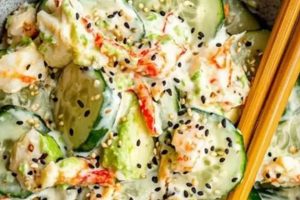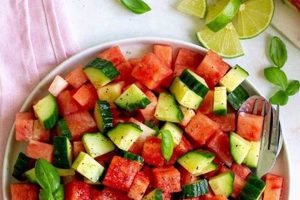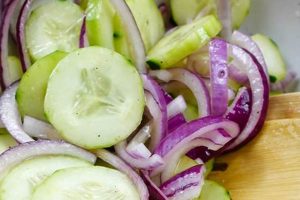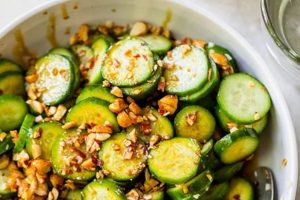A refreshing and simple dish, this type of salad combines the sweetness of ripe tomatoes with the cool crispness of cucumbers, all brought together by the tangy bite of vinegar. Variations can include additions such as onions, herbs, or other vegetables, with dressings ranging from simple vinaigrettes to more complex emulsified versions. A classic example features sliced tomatoes and cucumbers dressed with a mixture of vinegar, oil, salt, and pepper.
This salad offers numerous advantages. Its minimal ingredients and quick preparation make it an ideal side dish for busy weeknights or a light lunch option. The hydrating nature of cucumbers and tomatoes, coupled with the digestive benefits often associated with vinegar, contributes to its appeal as a healthy dietary choice. Historically, similar combinations of these ingredients have been enjoyed across various cultures for generations, highlighting the enduring popularity of this simple yet flavorful combination.
Further exploration will delve into specific variations, including detailed recipes, tips for selecting the best ingredients, and suggestions for complementary pairings. Discussions on nutritional value and potential health benefits will also be provided.
Tips for a Perfect Tomato Cucumber Vinegar Salad
Achieving optimal flavor and texture requires attention to detail in ingredient selection and preparation techniques. The following tips offer guidance for creating a truly exceptional salad.
Tip 1: Ingredient Quality is Paramount: Opt for ripe, in-season tomatoes for the best flavor. Vine-ripened varieties often offer superior sweetness. Cucumbers should be firm and blemish-free.
Tip 2: Proper Chilling Enhances Crispness: Chill both cucumbers and tomatoes before preparation. This enhances their refreshing qualities and contributes to a more satisfying textural experience.
Tip 3: Strategic Slicing Optimizes Texture: Consistent slicing ensures even marination and a pleasant mouthfeel. Aim for uniform slices of tomatoes and cucumbers, adjusting thickness based on personal preference.
Tip 4: Vinegar Selection Influences Flavor Profile: Experiment with different types of vinegar. White vinegar provides a classic tang, while apple cider vinegar offers a subtle sweetness. Red wine vinegar adds depth and complexity.
Tip 5: Salt Enhances Flavor and Draws Out Moisture: Salting the vegetables prior to dressing helps draw out excess moisture and intensifies their natural flavors. Allow salted vegetables to rest briefly before adding other ingredients.
Tip 6: Fresh Herbs Elevate the Salad: Incorporating fresh herbs such as dill, mint, or parsley can significantly elevate the flavor profile. Chop herbs finely and add them just before serving to maximize their aromatic impact.
Tip 7: Timing is Key for Optimal Flavor: While the salad can be enjoyed immediately, allowing it to marinate briefly enhances the melding of flavors. Avoid prolonged marinating, as this can lead to excessive softening of the vegetables.
By following these tips, one can ensure a consistently delicious and refreshing salad experience. Attention to detail in each step, from ingredient selection to final presentation, contributes significantly to the overall enjoyment of this simple yet versatile dish.
The following section will provide several variations on this classic recipe, offering inspiration for customization and exploration of diverse flavor combinations.
1. Fresh, Ripe Tomatoes
The foundation of a successful tomato cucumber vinegar salad rests significantly on the quality of its tomatoes. Fresh, ripe tomatoes contribute not only essential flavor but also desirable texture and visual appeal. Their selection and preparation are crucial considerations within the overall recipe.
- Flavor Contribution
Ripe tomatoes offer a complex interplay of sweetness, acidity, and umami, creating a nuanced flavor profile that complements the other salad components. The variety of tomato chosen plays a significant role; heirloom varieties often possess more pronounced sweetness and aromatic complexity compared to standard grocery store tomatoes. This depth of flavor forms the base upon which the other ingredients build, making the tomato a key flavor driver in the salad.
- Textural Impact
Ripe tomatoes provide a juicy, yielding texture that contrasts with the crispness of the cucumbers. Overripe tomatoes, however, can become mealy and detract from the overall textural balance. Selecting tomatoes with firm yet slightly yielding flesh is crucial for achieving the desired textural interplay.
- Visual Appeal
The vibrant colors of ripe tomatoes ranging from deep red to bright yellow and even shades of purple contribute significantly to the visual appeal of the salad. This vibrancy enhances the overall presentation and makes the dish more enticing. The choice of tomato variety can also influence the visual presentation, with heirloom tomatoes offering a diversity of shapes and colors.
- Nutritional Value
Fresh, ripe tomatoes are a good source of vitamins and antioxidants, further enhancing the health benefits of the salad. The nutritional content varies slightly depending on the variety and growing conditions, but generally, tomatoes contribute essential nutrients to the overall dish. This nutritional aspect adds to the appeal of the salad as a healthy dietary option.
The careful selection and preparation of fresh, ripe tomatoes ultimately determine the overall success of the tomato cucumber vinegar salad. Their contribution extends beyond mere flavor, impacting texture, visual appeal, and nutritional value. Understanding the importance of these facets allows for a more informed approach to ingredient selection and, consequently, a more enjoyable culinary experience.
2. Crisp Cucumbers
Cucumbers provide a crucial textural counterpoint to the softer tomatoes within the tomato cucumber vinegar salad. Their crispness adds a refreshing element and contributes significantly to the overall sensory experience. Understanding the factors influencing cucumber crispness and how to maintain it throughout preparation is essential for a successful salad.
- Variety Selection
Different cucumber varieties exhibit varying levels of crispness. English cucumbers, known for their thin skin and minimal seeds, tend to offer superior crunch compared to standard slicing cucumbers. Choosing the right variety is the first step in ensuring a crisp and refreshing salad. For instance, Persian cucumbers, smaller and thinner-skinned, are another excellent choice for maximizing crispness.
- Freshness and Storage
The freshness of the cucumber directly impacts its crispness. Cucumbers should be firm to the touch and free from blemishes. Proper storage is crucial for maintaining freshness; refrigeration in a crisper drawer helps retain moisture and prevent softening. Storing cucumbers wrapped in a slightly damp paper towel can further extend their crispness.
- Preparation Techniques
Slicing techniques influence the perceived crispness of cucumbers. Thin, even slices maximize surface area exposure to the dressing, potentially leading to some softening over time. Thicker slices or chunks retain their crunch more effectively. Additionally, scoring the cucumber lengthwise before slicing can create attractive ridges while maintaining structural integrity.
- Salting and Moisture Control
Cucumbers have high water content. Salting sliced cucumbers before adding them to the salad draws out excess moisture, preventing the salad from becoming watery and preserving the desired crispness. This step also seasons the cucumbers and enhances their flavor. After salting, patting the cucumbers dry with a paper towel further removes excess moisture.
The crispness of cucumbers contributes significantly to the refreshing quality and textural complexity of the tomato cucumber vinegar salad. Selecting the right variety, ensuring freshness, employing proper storage and preparation methods, and managing moisture content are all essential factors for maximizing this desirable characteristic and achieving a truly satisfying culinary experience.
3. Tangy Vinegar
Vinegar provides the essential acidic element that balances the sweetness of tomatoes and the mild flavor of cucumbers in a tomato cucumber vinegar salad. This acidity not only enhances the overall flavor profile but also contributes to preservation and textural integrity. The specific type of vinegar chosen significantly influences the final taste, offering a range of flavor profiles from the sharp bite of white vinegar to the mellow sweetness of apple cider vinegar or the complexity of red wine vinegar. The quantity used also plays a crucial role; too much vinegar can overpower the other flavors, while too little may result in a bland salad lacking the desired brightness. A classic vinaigrette, for example, typically employs a ratio of one part vinegar to three parts oil, but this can be adjusted based on personal preference and the specific type of vinegar used. The interaction between the vinegar and other ingredients, such as herbs and spices, further contributes to the overall complexity of the salad’s flavor profile. For instance, the herbaceous notes of dill pair well with the sharpness of white vinegar, while the fruity undertones of a balsamic vinegar complement the sweetness of ripe tomatoes.
Beyond flavor enhancement, vinegar plays a functional role in preserving the salad. The acidic environment created by the vinegar inhibits the growth of bacteria, extending the shelf life of the salad. This preservative quality was particularly important historically, before refrigeration was readily available. Furthermore, the vinegar’s acidity interacts with the cell walls of the vegetables, contributing to desirable textural changes. While prolonged exposure to vinegar can lead to excessive softening, a brief marination period can enhance the crispness of cucumbers and tomatoes. This balance between flavor, preservation, and texture makes vinegar an indispensable component of the tomato cucumber vinegar salad.
Understanding the multifaceted role of vinegar in this simple salad allows for greater control over the final product. Careful selection of the vinegar type and attention to quantity ensure a balanced and flavorful dish. Recognizing vinegar’s impact on both taste and texture empowers one to create a salad tailored to individual preferences, highlighting the importance of this seemingly simple ingredient within the overall culinary composition.
4. Simple Seasonings
Simple seasonings play a crucial role in elevating the flavor profile of a tomato cucumber vinegar salad. While the fresh ingredients provide a foundational taste, careful seasoning enhances their inherent qualities and creates a more complex and satisfying culinary experience. The choice and application of seasonings can significantly impact the overall balance and depth of flavor within the salad.
- Salt
Salt is fundamental, enhancing the natural sweetness of the tomatoes and cucumbers while also drawing out excess moisture. This dual action intensifies flavors and contributes to a desirable textural balance. The type of salt used can also influence the final taste. Coarse kosher salt or sea salt offers a cleaner flavor compared to standard table salt, while flavored salts, such as smoked salt or Himalayan pink salt, can add unique nuances. The timing of salt addition is also important; salting the vegetables briefly before combining them with other ingredients allows for better moisture control and flavor penetration.
- Black Pepper
Freshly ground black pepper adds a subtle warmth and complexity to the salad. Its pungent aroma complements the other ingredients without overpowering the delicate flavors. Pre-ground pepper often lacks the vibrancy of freshly ground peppercorns, so grinding pepper just before adding it to the salad maximizes its aromatic contribution.
- Herbs
Fresh herbs provide a bright, aromatic dimension. Dill, mint, parsley, and chives are popular choices, each offering a distinct flavor profile. Dill’s slightly tangy flavor pairs well with cucumbers, while mint adds a refreshing coolness. Parsley provides a clean, herbaceous note, and chives offer a mild onion flavor. Adding herbs just before serving preserves their delicate flavors and maximizes their aromatic impact.
- Other Flavor Enhancers
A small amount of sugar can balance the acidity of the vinegar and enhance the sweetness of the tomatoes. A pinch of red pepper flakes adds a touch of heat, while a finely minced garlic clove provides a pungent savory note. These additions, used sparingly, can further customize the flavor profile to individual preferences. For example, a touch of smoked paprika can introduce a smoky depth, while a squeeze of lemon juice adds a burst of citrusy brightness.
The judicious use of simple seasonings transforms the tomato cucumber vinegar salad from a basic combination of ingredients into a vibrant and flavorful dish. Understanding the specific contributions of each seasoning, from the foundational role of salt to the nuanced enhancements offered by herbs and other flavor enhancers, allows for precise control over the final taste and elevates this simple salad to a new level of culinary sophistication.
5. Optional Add-ins
Optional add-ins offer opportunities to personalize the flavor and textural profile of a tomato cucumber vinegar salad, transforming it from a simple dish into a more complex and nuanced culinary creation. These additions, while not essential to the core recipe, can significantly impact the overall sensory experience. Understanding the potential contributions of various add-ins allows for strategic customization based on individual preferences and desired outcomes.
Consider the addition of thinly sliced red onion. Its sharp, pungent flavor provides a counterpoint to the sweetness of the tomatoes, adding a layer of complexity. Simultaneously, the onion’s crisp texture contributes another dimension to the salad’s mouthfeel. Incorporating crumbled feta cheese introduces a salty, creamy element that complements the tanginess of the vinegar. Chopped fresh herbs, such as dill, mint, or parsley, introduce bright aromatic notes, further enhancing the salad’s refreshing qualities. Other vegetables, like bell peppers or chopped celery, contribute varied textures and flavors. Even the addition of a sprinkle of toasted sesame seeds or chopped walnuts can transform the salad’s textural and flavor profile. A combination of red onion, feta cheese, and fresh dill, for instance, creates a Mediterranean-inspired variation, while adding chopped bell peppers and a sprinkle of chili flakes results in a spicier, more vibrant salad.
The strategic incorporation of optional add-ins expands the versatility of the tomato cucumber vinegar salad. Careful consideration of flavor pairings and textural interplay allows for customized variations that cater to diverse palates. This flexibility makes the salad adaptable to different meal occasions and dietary preferences, highlighting the practical significance of understanding the potential contributions of various add-ins.
6. Proper Slicing Technique
Proper slicing technique significantly influences the final quality of a tomato cucumber vinegar salad. Uniformity of slices affects both the aesthetic presentation and the overall eating experience. Consistent slicing ensures even distribution of the vinaigrette, allowing each piece to be adequately coated and seasoned. This uniformity also promotes balanced flavor, as each bite contains a similar ratio of tomato, cucumber, and dressing. Conversely, uneven slicing can lead to some pieces being over-dressed while others remain under-seasoned, resulting in a less harmonious flavor profile. Furthermore, consistent size and shape contribute to a more pleasing textural experience. Imagine a salad with some pieces diced small and others sliced thickly; the mouthfeel would be uneven and potentially less enjoyable. A salad composed of uniformly sliced vegetables offers a more refined and satisfying sensory experience.
Beyond aesthetics and flavor, proper slicing technique impacts the structural integrity of the salad. Thinly sliced vegetables, particularly cucumbers, are more prone to releasing excess moisture, potentially leading to a watery salad. Slightly thicker slices retain their structure better, maintaining the desired crispness and preventing the salad from becoming diluted. Consider the difference between thinly shaved cucumbers and thicker, half-moon slices in a salad. The shaved cucumbers will release more water and soften more quickly, while the thicker slices will retain their crunch and contribute to a more textural complexity. The choice of slicing technique, therefore, directly influences the salad’s overall texture and its ability to hold up over time.
In summary, proper slicing technique is integral to the success of a tomato cucumber vinegar salad. It impacts not only the visual appeal but also the flavor balance, textural consistency, and overall enjoyment of the dish. Achieving uniform slices ensures even distribution of dressing, promotes balanced flavor, contributes to a pleasing mouthfeel, and helps maintain the structural integrity of the vegetables. Understanding the impact of slicing technique empowers one to create a salad that is both visually appealing and deliciously satisfying.
7. Chilling Before Serving
Chilling a tomato cucumber vinegar salad prior to serving significantly enhances its sensory appeal and overall enjoyment. Temperature plays a crucial role in the perception of flavor and texture, particularly in a salad composed primarily of fresh, raw ingredients. Lowering the temperature of the salad intensifies the refreshing qualities of the cucumbers and tomatoes, while also enhancing the crispness of the vegetables and the brightness of the vinaigrette.
- Enhanced Flavor Perception
Chilling accentuates the natural sweetness of ripe tomatoes and the refreshing coolness of cucumbers. The colder temperature also heightens the perception of acidity in the vinaigrette, creating a more vibrant and balanced flavor profile. A chilled salad offers a more pronounced and refreshing taste compared to a room-temperature version, where the flavors may be muted or less distinct.
- Improved Textural Experience
Lower temperatures firm the cell walls of the vegetables, resulting in a crisper, more satisfying texture. This enhanced crispness provides a pleasant contrast to the slight softness of the tomatoes and adds to the overall textural complexity of the salad. A chilled salad maintains its structural integrity better, preventing the vegetables from becoming overly soft or wilted.
- Increased Refreshment
A chilled salad offers a more refreshing and revitalizing experience, particularly in warm weather. The cool temperature provides a welcome contrast to the ambient heat, enhancing the perception of coolness and refreshment. This makes a chilled tomato cucumber vinegar salad an ideal choice for summer meals or as a light and refreshing side dish.
- Preservation of Quality
Chilling slows down enzymatic activity within the vegetables, helping to preserve their freshness and prevent premature spoilage. This extended shelf life allows the salad to maintain its optimal quality for a longer period, reducing food waste and ensuring a consistently enjoyable culinary experience. While not a substitute for proper food storage practices, chilling does contribute to maintaining the salad’s freshness and flavor.
Chilling a tomato cucumber vinegar salad before serving is a simple yet impactful step that elevates the entire dining experience. The lower temperature enhances flavor perception, improves textural qualities, increases refreshment, and contributes to the preservation of the salad. By understanding the influence of temperature on sensory perception, one can optimize the enjoyment of this simple yet versatile dish.
Frequently Asked Questions
This section addresses common inquiries regarding the preparation and enjoyment of tomato cucumber vinegar salads.
Question 1: How long can this salad be stored?
Properly stored in an airtight container in the refrigerator, the salad typically maintains optimal quality for up to three days. Beyond this timeframe, textural changes and flavor degradation may occur.
Question 2: Can other vegetables be added?
Certainly. Bell peppers, red onion, and chopped celery are common additions. However, consider the impact on overall flavor and texture. Strong-flavored vegetables, such as onions, should be used sparingly to avoid overpowering the delicate flavors of the tomatoes and cucumbers.
Question 3: What type of vinegar is recommended?
White vinegar, apple cider vinegar, and red wine vinegar are frequently used. Each offers a distinct flavor profile. Experimentation is encouraged to determine individual preferences. The intensity of the vinegar’s flavor should also be considered; stronger vinegars may require dilution to achieve a balanced taste.
Question 4: Is salting the cucumbers necessary?
Salting cucumbers prior to adding them to the salad helps draw out excess moisture, preventing a watery final product. This step also enhances the cucumbers’ flavor. While not strictly mandatory, it contributes significantly to the salad’s overall quality.
Question 5: Can this salad be made ahead of time?
Preparing the salad a few hours in advance allows the flavors to meld. However, prolonged marinating can lead to excessive softening of the vegetables. For optimal texture, it’s generally recommended to dress the salad shortly before serving.
Question 6: How can the salad’s flavor profile be adjusted?
Adjusting the type and quantity of vinegar, adding herbs and spices, or incorporating other vegetables allows for customization. A touch of sugar can balance acidity, while a pinch of red pepper flakes adds heat. Experimentation is key to achieving desired flavor combinations.
Understanding these frequently asked questions helps ensure consistent success in preparing and enjoying a delicious and refreshing tomato cucumber vinegar salad. Attention to detail in each step, from ingredient selection to storage, contributes to a truly satisfying culinary experience.
The following section offers a collection of recipe variations, providing further inspiration and guidance for customizing this versatile dish.
Tomato Cucumber Vinegar Salad Recipe
Exploration of this deceptively simple culinary composition reveals a depth of factors influencing its ultimate success. From the selection of ripe, in-season tomatoes and crisp cucumbers to the nuanced interplay of vinegar, seasonings, and optional additions, each component contributes significantly to the final product. Proper slicing techniques and chilling further enhance the salad’s sensory appeal, maximizing flavor, texture, and overall enjoyment. Attention to these details elevates the dish from a basic combination of ingredients to a refreshing and flavorful culinary experience.
The enduring popularity of this salad underscores its adaptability and timeless appeal. Continued exploration of ingredient variations and flavor combinations offers boundless opportunities for culinary creativity. This seemingly simple dish serves as a testament to the profound impact achievable through careful attention to detail and a thoughtful approach to ingredient selection and preparation.






